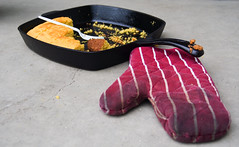- in Green Home by Alexis Rodrigo
How To Cook Green
“Green” cooking refers to more than the color of your foods. Truly green or eco-friendly cooking covers your choice of foods and how they are prepared.
Here are some ideas for greening your culinary efforts:
Cookware
1. Choose long-lasting materials to reduce waste, such as cast iron.
2. Buy used cookware at your local antique store, yard sale, or second-hand shop. Make sure, however, that pots and pans are not warped, as this can effect heat conduction.
3. Make sure you use a pot on the right-sized stove eye. Using too small a pot on a large burner (or vise versa) wastes heat and energy.
4. Choose utensils that are made from sustainable materials, like bamboo. Avoid plastic. Utensils and flatware are also plentiful at antique shops and yard sales.
5. Choose cookware made from metals that conduct heat well: copper, cast iron, aluminum (use anodized aluminum if you have health concerns).
6. Avoid Teflon and non-stick coated pans; toxic chemicals known as polytetrafluoroethylene (PTFE) and perfluorooctanoic acid (PFOA) are used in the coating.
7. Buy cookware with an eco-friendly, non-stick finish, such as enamelware, anodized aluminum, or by a new process known as nanotechnology. Also, seasoning your cast iron and cleaning it properly (no soap) will create a natural, non-stick finish.
8. Stainless steel is not a very good conductor of heat, but it is recyclable.
Energy Use
1. If possible, upgrade to a convection oven, which cooks food far faster than a conventional oven.
2. Use a pressure cooker to cut down on cooking time. Whole grains can be cooked in half the time, and meats can be cooked with the “all day tender” flavor and texture in under an hour.
3. Use a slow cooker on low for long-term cooking. It uses less energy than baking something in an oven for hours.
4. Cook outside. And while you are out there cooking, turn off the heat or air conditioning in the house!
5. Use residual heat. This works especially well for cooking greens and steaming vegetables. Cover the pot tightly, bring the water to a boil and then turn off the burner, leaving the pot on the burner. The vegetables will continue to cook with the residual heat.
6. Cover your pots and pans to lessen cooking time. This is especially true when boiling water.
Food
1. Buy local food. It takes less gas to get local food to the market, and such produce is not likely to be sprayed with preservatives or other chemicals applied for long transport.
2. Cut and chop foods into small pieces before cooking; they’ll cook a lot faster.
3. Cook foods simultaneously to cut down on the total time you are using your stove.
4. Limit the trips to the fridge. Think through what you need to get out of the refrigerator and get it in one trip. It’s worth it to hold the refrigerator a few minutes longer to get all that you need to prevent opening and closing the refrigerator door dozens of times.
5. Buy organic foods, which are better for the environment for so many reasons. Not only are organic foods free of synthetic agrichemicals, they are also a component of sustainable agriculture, assuring productive farms for the future.
![]() photo credit: Unhindered by Talent
photo credit: Unhindered by Talent
If you liked this post, submit your email address below to get new posts by email:

